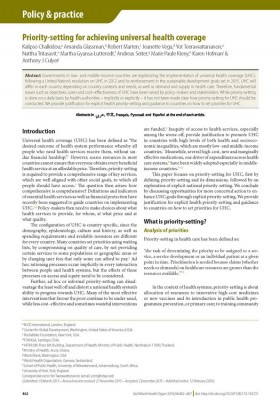This website uses cookies so that we can provide you with the best user experience possible. Cookie information is stored in your browser and performs functions such as recognising you when you return to our website and helping our team to understand which sections of the website you find most interesting and useful.
Priority-setting for achieving universal health coverage (2016)

Details
Kalipso Chalkidou , Amanda Glassman , Robert Marten , Jeanette Vega ,
Yot Teerawattananon , Nattha Tritasavit , Martha Gyansa-Lutterodt , Andreas Seiter
Marie Paule Kieny , Karen Hofmani , Anthony J Culyerj
Abstract
Governments in low- and middle-income countries are legitimizing the implementation of universal health coverage (UHC), following a United Nation’s resolution on UHC in 2012 and its reinforcement in the sustainable development goals set in 2015. UHC will differ in each country depending on country contexts and needs, as well as demand and supply in health care. Therefore, fundamental issues such as objectives, users and cost–effectiveness of UHC have been raised by policy-makers and stakeholders. While priority-setting is done on a daily basis by health authorities – implicitly or explicitly – it has not been made clear how priority-setting for UHC should be conducted. We provide justification for explicit health priority-setting and guidance to countries on how to set priorities for UHC.
Full Text: http://www.who.int/bulletin/volumes/94/6/15-155721.pdf




